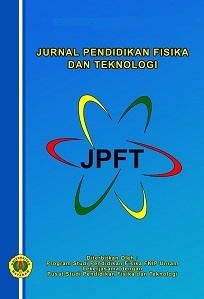Pengukuran Tekanan Absolut Biogas Berbahan Campuran Eceng Gondok Dan Kotoran Sapi
DOI:
10.29303/jpft.v5i1.988Published:
2019-03-06Issue:
Vol. 5 No. 1 (2019): Januari - JuniKeywords:
Absolute pressure, Biogas, Water Hyacinth, Renewable EnergyArticles
Downloads
How to Cite
Downloads
Metrics
Abstract
Biogas techniques is a way to produce energy with the anaerobic process by utilizing organic ingredients, one of which can be derived from herbs. The quality of biogas production can be viewed by performing the measurement of absolute pressure of biogas. Absolute pressure is the atmospheric pressure coupled with the measured pressure.ÃÂ The magnitude of the pressure will affect the quality of the flame produced biogas. This study, using the method of observation, and measurements. As for the data analysis techniques,. The findings focused to find the different of biogas production by measuring the change in absolute pressure of biogas. Measurements are done using a manometer. The results obtained show that the introduction by using cow dung retrieved changes pressure biogas occurred on day 3 with pressure 140.565 N/m2, the characteristics of the data graph illustrates the R2 = 0.677. Different results are indicated on the mixing water hyacinth with cow manure, biogas pressure changes happen on day 1 with the characteristic graph of a R2 = 0.976. This condition describes that the mixing of the water hyacinth and cow dung provides distinctions signifikant in accelerating the process of occurrence of biogas
.References
Laili, R. 2015. Enceng Gondok Sebagai Biogas Yang Ramah Lingkungan. Jurnal Ilmiah Tekno, 12(1), 01-10.
Peraturan Pemerintah No.3 Tahun 2005 tentang Penyediaan dan Pemanfaatan Tenaga Listrik.
Peraturan Pemerintah Nomor 79 Tahun 2014 tentang Kebijakan Energi Nasional.
Putra, G. M. D., Abdullah, S. H., Priyati, A., Setiawati, D. A., & Muttalib, S. A. 2017. Rancang Bangun Reaktor Biogas Tipe Portable dari Limbah Kotoran Ternak Sapi. Jurnal Ilmiah Rekayasa Pertanian dan Biosistem, 5(1), 369-374.
Riswanto, R. 2017. PEMETAAN POTENSI BIOGAS DI KOTA METRO. Jurnal Pendidikan Fisika, 5(2), 126-137.
Rohyami. 2012. (online) .Hukum Gas ideal, http://rohyami.staff.uii.ac.id/2012/05/07/gas/ diakses pada 17 Juli 2018
Undang-Undang Republik Indonesia. No. 33 Tahun 2007 tentang Energi.
Wahyuni, S. 2013. Panduan praktis biogas. Penebar Swadaya Grup.
Wahyuni, S., & MP, S. 2011. Menghasilkan Biogas dari Aneka Limbah (Revisi). AgroMedia.
Yonathan, A., Prasetya, A. R., & Pramudono, B. 2013. Produksi Biogas dari Eceng Gondok (Eicchornia crassipes): Kajian Konsistensi dan pH Terhadap Biogas Dihasilkan. Jurnal Teknologi Kimia dan Industri, 211-215.
Author Biographies
Riswanto Riswanto, Pendidikan Fisika, Universitas Muhammadiyah Metro
Sodikin Sodikin, Pendidikan Fisika, Universitas Muhammadiyah Metro
License
Authors who publish with Jurnal Pendidikan Fisika dan Teknologi (JPFT) agree to the following terms:
- Authors retain copyright and grant the journal right of first publication with the work simultaneously licensed under a Creative Commons Attribution License 4.0 International License (CC-BY-SA License). This license allows authors to use all articles, data sets, graphics, and appendices in data mining applications, search engines, web sites, blogs, and other platforms by providing an appropriate reference. The journal allows the author(s) to hold the copyright without restrictions and will retain publishing rights without restrictions.
- Authors are able to enter into separate, additional contractual arrangements for the non-exclusive distribution of the journal's published version of the work (e.g., post it to an institutional repository or publish it in a book), with an acknowledgement of its initial publication in Jurnal Pendidikan Fisika dan Teknologi (JPFT).
- Authors are permitted and encouraged to post their work online (e.g., in institutional repositories or on their website) prior to and during the submission process, as it can lead to productive exchanges, as well as earlier and greater citation of published work (See The Effect of Open Access).











